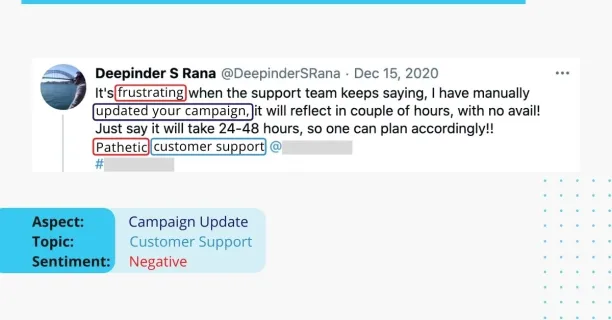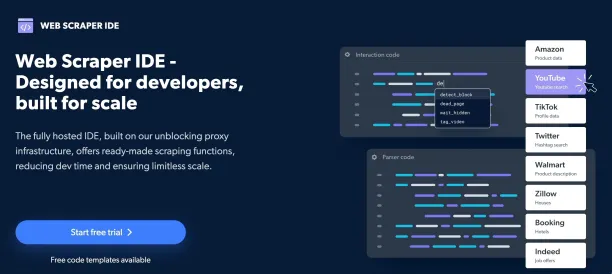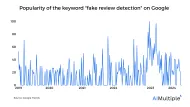Top 4 Real-Life Examples of Sentiment Analysis in 2024
There is a huge amount of user-generated data on social media platforms and websites. Customers share their thoughts, feedback, and expectations regarding companies’ services and products on various websites. All of these types of content give companies important insights for analyzing their brand reputation, services, and products. Natural language processing (NLP) comes into play here. It converts unstructured text into data that can be analyzed.
One of the most popular NLP techniques is sentiment analysis, which is used to state how a person feels about a situation. It assigns a value to each piece of text, such as positive, negative, or neutral. We’ll explore several sentiment analysis use cases.
1. Product Design and Improvement
Sentiment analysis application helps companies understand how their customers feel about their products. For companies, social media comments have become the voice of customers and segment analysis. Customers use social media to express their thoughts on any product.
It captures customers’ complaints about a product and enables business leaders and analysts to fix bugs and issues and improve their products based on customers’ needs.
For example;
“The user interface is simple and does not necessitate extensive technical knowledge.” This sentence is classified as a positive comment by sentiment analysis.
“Working with large datasets is sometimes a struggle.” Sentiment analysis would classify the second comment as negative.
Sentiment analysis collects data from customers about your products. To express how your customers feel about your product, assign each comment a value between +1 and -1.
From anonymous review websites such as Glassdoor, it is possible to collect information about your company and reveal feedback that you would not expect. For example, Starbucks conducted a detailed analysis with Glassdoor data and found that 60% of their employees expressed faith in their senior leadership.

2. Call Center Sentiment Analysis
Companies use sentiment analysis tools to monitor their call center agents’ live phone interactions or chat sessions with customers in real-time. Call duration with speech recognition automatically detects customer emotions. Companies can better understand how customer satisfaction varies by product and call center services.
Monitoring customer service calls allows companies to assess the performance of the call center and identify the problems in certain departments based on negative feedback from customers. In doing so, managers can improve the service process and their training programs.

Sponsored:
Web scraping tools can extract web data from targeted websites for businesses. Bright Data’s Data Collector extracts data from any public website. By utilizing Bright Data’s IDE, users can create their own collector. Another option for scraping a website is a ready-made collector that suits your needs.
Check out Bright Data’s blog to learn more about how they assist companies with consumer sentiment analysis.

3. Measuring customer satisfaction
Your business may have an online rating on an e-commerce platform or on Google. However, the information you can get about your customers’ opinion of your brand is not just limited to one overall number. Online reviews can reveal the what strongest and weakest features of your product or service are. You can identify the pain points that frustrate your customers to improve.
For example, a 2021 research analyzed thousands of airline reviews from Skytrax and revealed that the highest majority of the negative sentiments were related to delays and timing. This is a data-driven insight for leaders to apply in all sources that they gather customer input from, such as customer service recordings or online reviews, and decide which services they should invest in for improvement.
4. Monitoring brand reputation
Before the internet became a big part of our lives, market research was limited to focus group studies and offline surveys. These often took a long time to complete and were also costly. Now, web data offers a plethora of organic consumer opinions. Especially social media sources like Twitter or forums like Reddit are rich in people’s honest opinions and experiences with different brands and businesses. For example, when Procter & Gamble launched their Gillette campaign “The Best A Man Can Get”, it received a mixed public reception. However, a sentiment analysis study on thousands of Twitter posts revealed that the overall sentiment of the ad was more positive than negative.
Sentiment analysis allows companies to monitor their brands’ reputations across social media channels. It extracts customers’ feelings behind their messages and posts. Thereby, companies get valuable insight into their products, services, and brands by applying sentiment analysis to social media pots.
When looking for local businesses in 2021, 77% of consumers read online reviews ‘always’ or ‘regularly’ (up from 60 percent in 2020). 57% of customers think they would be “not very” or “not at all” inclined to use a company that does not reply to online reviews.
For more on web scraping and sentiment analysis:
Check out our data-driven list of web scrapers for guidance in choosing the right tool, and feel free to contact us:


Comments
Your email address will not be published. All fields are required.